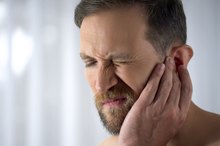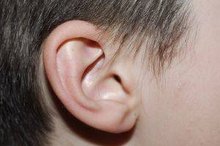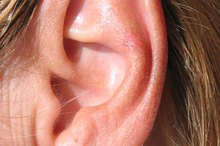Waterpik Ear Wax Removal
Removing earwax usually requires nothing more than wiping loose wax from the opening of the ear, but in some cases the wax or cerumen collects in the ear canal, creating a health condition known in medical circles as cerumen impaction. Various options exist for removing this compacted wax, including flushing with water. Although you may have heard of flushing the ear using a jet irrigator, such as the brand known as Waterpik, make sure you know the basic facts about this method of wax removal before opting to use a jet irrigator on your affected ear, especially if you experience symptoms of a punctured eardrum.
If you are experiencing serious medical symptoms, seek emergency treatment immediately.
The Facts
Impacted cerumen may develop in people of all ages but occurs most frequently in special needs individuals and the geriatric population, notes the American Academy of Family Physicians 1. Factors that may contribute to the development of earwax buildup include narrow ear canals, excessive hair growth in the ear canals and improper ear cleaning techniques, as well as the use of external devices, such as hearing aids and ear plugs. Signs of compacted wax include gradual hearing loss, dizziness, ear pain and a feeling of fullness in the ear canal of the affected ear.
Function
Baking Soda & Water for Ear Wax
Learn More
Flushing wax from the ear requires you to direct a flow of water into the ear canal, which may soften and remove the buildup of wax. Designed for cleaning teeth, a Waterpik jet irrigator creates a forceful flow of water that shoots from the nozzle of the irrigator. Directing this flow of forced water into the ear canal may loosen compacted cerumen, according to Dr. Albert Menner, a practicing otolaryngologist and author of the book “A Pocket Guide to the Ear.” However, Dr. Menner notes that the device should always be placed on its lowest setting to minimize the water pressure 2.
Warning
MedlinePlus Medical Encyclopedia warns against using jet irrigators, such as a Waterpik, to attempt the removal of compacted earwax 34. When used by inexperienced individuals, the strong water pressure that comes from jet irrigators could actually lead to further complications, such as eardrum damage or perforation. In certain instances, damage to the eardrum could cause additional problems, including permanent loss of hearing, ear infections and mastoiditis or infection of the bone behind the ear.
Alternatives
Smelly Ear Wax
Learn More
Using a Waterpik dental device is not your only option for loosening and removing earwax. According to MedlinePlus, other safer alternatives include wax-softening drops and irrigation with a syringe. Acceptable wax-softening solutions for softening the built-up cerumen include baby oil, glycerin, mineral oil and hydrogen peroxide. If you decide to irrigate the affected ear with a syringe, stick with body-temperature water to minimize side effects, such as vertigo, that may occur during the irrigation procedure.
- Using a Waterpik dental device is not your only option for loosening and removing earwax.
- According to MedlinePlus, other safer alternatives include wax-softening drops and irrigation with a syringe.
Considerations
Talk to your doctor before attempting to remove compacted cerumen using any home remedies, including a Waterpik or other jet irrigator. Depending upon your personal medical history, your doctor may conduct a physical exam of your ear, as well as make recommendations regarding the most appropriate method of wax removal. In certain instances, your doctor may opt to manually remove the wax himself, especially if you may have a punctured eardrum or ear tubes, as well as certain medical conditions, including diabetes, according to the American Academy of Otolaryngology-Head and Neck Surgery 5.
Related Articles
References
- American Academy of Family Physicians: Cerumen Impaction
- “A Pocket Guide to the Ear”; Albert Menner, MD; 2003
- MedlinePlus Medical Encyclopedia: Wax Blockage
- MedlinePlus Medical Encyclopedia: Ruptured Eardrum
- American Academy of Otolaryngology-Head and Neck Surgery: Earwax
- AAO-HNSF Clinical Practice Guideline: Earwax Removal (8/29/2008). American Academy of Otolaryngology- Head and Neck Surgery.
- Klein, Sarah. "This Will Make You Never, Ever Want To Clean Your Ears Again" (7/21/2014). The Huffington Post.
Writer Bio
Regan Hennessy has been writing professionally for 11 years. A copywriter and certified teacher, Hennessy specializes in the areas of parenting, health, education, agriculture and personal finance. She has produced content for various websites and graduated from Lycoming College with a Bachelor of Arts in English.








